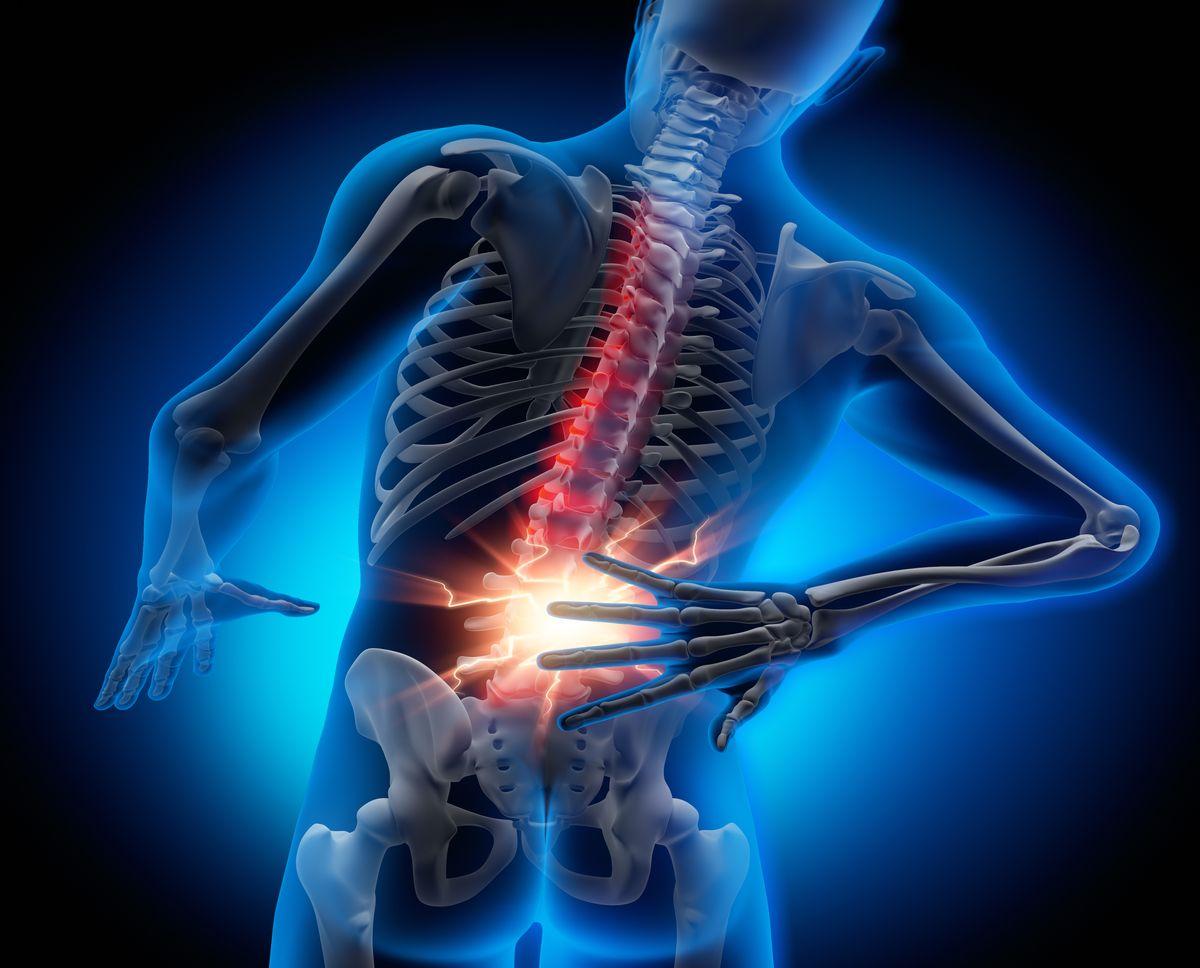SPONDYLARTHRITIS
Fast Facts
- Spondyloarthritis is a type of arthritis that attacks the spine and, in some people, the joints of the arms and legs. It can also involve the skin, intestines and eyes. The main symptom (what you feel) in most patients is low back pain. This occurs most often in axial spondyloarthritis.
- In a minority of patients, the major symptom is pain and swelling in the arms and legs. This type is known as peripheral spondyloarthritis.
- People in their teens and 20s, particularly males, are affected most often. Family members of those with spondyloarthritis are at higher risk.
- Many people with axial spondyloarthritis progress to having some degree of spinal fusion, known as ankylosing spondylitis. This more often strikes young males.
- Non-steroidal anti-inflammatory drugs (commonly called NSAIDs) offer symptom relief for most patients by reducing pain and swelling. Other medicines called biologics, including anti-TNF drugs (TNF blockers) and anti-IL-17 drugs (IL-17 blockers) are effective in patients who do not respond well enough to NSAIDs.
- Newer treatments have helped a great deal in controlling symptoms. Frequent fitness activities and back exercises are important in managing the symptoms of spondyloarthritis.
Spondyloarthritis (or spondyloarthropathy) is the name for a family of inflammatory rheumatic diseases that cause arthritis. It differs from other types of arthritis, because it involves the sites where ligaments and tendons attach to bones called “entheses.” Symptoms present in two main ways. The first is inflammation causing pain and stiffness, most often of the spine. Some forms can affect the hands and feet or arms and legs. The second type is bone destruction causing deformities of the spine and poor function of the shoulders and hips.
The most common is ankylosing spondylitis, which affects mainly the spine. Others include:
- axial spondyloarthritis, which affects mainly the spine and pelvic joints
- peripheral spondyloarthritis, affecting mostly the arms and legs
- reactive arthritis (formerly known as Reiter’s syndrome)
- psoriatic arthritis
- enteropathic arthritis/spondylitis associated with inflammatory bowel diseases (ulcerative colitis and Crohn’s disease).
What causes spondyloarthritis?
Ankylosing spondylitis is hereditary. Many genes can cause it. Up to 30 of these genes have been found. The major gene that is associated with this disease is HLA-B27. Almost all white people with ankylosing spondylitis are carriers of HLA-B27.
Enteropathic arthritis is a form of chronic, inflammatory arthritis. The two most common types are ulcerative colitis and Crohn’s disease. The cause of enteropathic arthritis is unclear. It may be due to bacteria that enter the bowel when inflammation damages it. People with HLA-B27 are more likely to have this form of arthritis than those without the gene.
Discussions of the causes and risk factors for other members of the spondyloarthritis family appear in their own fact sheets.
Who gets spondyloarthritis?
Ankylosing spondylitis tends to start in the teens and 20s and strikes males two to three times more often than females. Family members of affected people are at higher risk, depending partly on whether they inherited the HLA-B27 gene.
There is an uneven ethnic distribution of ankylosing spondylitis. The highest frequency appears in the far north in cultures such as Alaskan and Siberian Eskimos and Scandinavian Lapps (also called Samis), who have a higher frequency of HLA-B27. It also occurs more often in certain Native American tribes in the western U.S. and Canada. African Americans are affected less often than other races.
Based on data from the National Health and Nutrition Examination Survey (NHANES), the frequency of ankylosing spondylitis in the U.S., is 0.5 percent. The frequency for axial spondyloarthritis is 1.4 percent.
How is spondyloarthritis diagnosed?
Correct diagnosis requires a physician to assess the patient’s medical history and do a physical exam. The doctor also may order imaging tests or blood tests. You may need an X-ray of the sacroiliac joints, a pair of joints in the pelvis. X-ray changes of the sacroiliac joints, known as sacroiliitis, are a key sign of spondyloarthritis. If X-rays do not show enough changes, but the symptoms are highly suspicious, your doctor might order magnetic resonance imaging, or MRI, which shows these joints better and can pick up early involvement before an X-ray can.
Among the blood tests you may need is a test for the HLA-B27 gene. However, having this gene does not mean spondyloarthritis will always develop. Many people have the HLA-B27 gene but do not have arthritis and never develop arthritis. In the end, the diagnosis relies on the doctor’s judgment.
How is spondyloarthritis treated?
All patients should get physical therapy and do joint-directed exercises. Most recommended are exercises that promote spinal extension and mobility.
There are many drug treatment options. The first lines of treatment are the NSAIDs, such as naproxen, ibuprofen, meloxicam or indomethacin. No one NSAID is superior to another. Given the correct dose and duration, these drugs give great relief for most patients.
For joint swelling that is localized (not widespread), injections, or shots, of corticosteroid medications into joints or tendon sheaths (the membrane around a tendon) can be effective quickly.
For patients who do not respond to the above lines of treatment, disease modifying antirheumatic drugs (commonly called DMARDs) such as sulfasalazine (Azulfidine) might be effective. These drugs relieve symptoms and may prevent damage to the joints. This class of drugs is helpful mainly in those with arthritis that also affects the joints of the arms and legs.
Although they may be effective, corticosteroids taken by mouth are not advised. This is because the high dose required will lead to many side effects.
Antibiotics are an option only for patients with reactive arthritis.
Some members of a newer class of drugs known as biologics) are very effective in treating both the spinal and peripheral joint symptoms of spondyloarthritis.
Broader health impacts
Other problems can occur in patients with spondyloarthritis. You should discuss possible complications with your doctor. These can include:
- Osteoporosis, which occurs in up to half of patients with ankylosing spondylitis, especially in those whose spine is fused. Osteoporosis can raise the risk of spinal fracture.
- Inflammation of part of the eye, called uveitis, which occurs in about 40% of those with spondyloarthritis. Symptoms of uveitis include redness and pain of the eye. Steroid eye drops most often are effective, though severe cases may need other treatments from an ophthalmologist (eye MD).
- Inflammation of the aortic valve in the heart, which can occur over time in patients with spondylitis. Your doctor should check your heart to make sure you do not have this problem.
- Psoriasis, a patchy skin disease, which if severe will need treatment by a dermatologist (skin doctor).
- Intestinal inflammation, which may be so severe that it requires treatment by a gastroenterologist (doctor who specializes in digestive diseases).
Living with spondyloarthritis
Pain, fatigue and stiffness can be continuous or off and on. Despite these symptoms, most patients with spondyloarthritis lead productive lives and have a normal lifespan, especially with the newer treatments available. There are things you can do to improve your health. Frequent exercise is essential to maintain joint and heart health. If you smoke, try to quit. Smoking aggravates spondyloarthritis and can speed up the rate of spinal fusion. Patient support groups provide support and helpful information. These groups are available through the Spondylitis Association of America, the National Psoriasis Foundation or the Arthritis Foundation.
Updated March 2019 by Kwas Huston, MD, and reviewed by the American College of Rheumatology Communications and Marketing Committee.
This information is provided for general education only. Individuals should consult a qualified health care provider for professional medical advice, diagnosis and treatment of a medical or health condition.

